Real Madrid – Barcelona 0:4
Saturday held the first Clasico of the season, with two of the most dominant teams clash in what is the biggest match in domestic football.
Barcelona travels to the capital sitting at the top of the table despite being without Lionel Messi for an extended period of games as Neymar has shone in the Argentine’s absence. After replacing Carlo Ancelotti, Rafa Benitez has struggled in management of Real Madrid who have looked fairly unimpressive in performances so far. In the Clasico we saw yet another weak performance from Real Madrid where again collective-tactical issues were at the forefront.
With Messi only contained to the bench, Sergi Roberto took on a role on the right wing and otherwise, the system was the same from what has given Lucho Enrique so much success in his short time at the club.
Despite fielding Casemiro as a lone 6 quite commonly this year, Benitez actually opted away from this and decided on more of a 4-2-4 formation in attack. With only Kroos and Modric as midfielders in the centre, an attacking front 4 was selected with James, Bale, Ronaldo and Benzema all trying to fit into an ultimately dysfunctional attack.
Madrid with a Disconnected Possession Game…
For quite an extended period now, Real Madrid have been plagued with a weak possession game which has seen their failings against stronger clubs. Only somewhat redeemed by the excellence of Kroos and Modric in the centre of midfield, Benitez (or Perez)’ insistence on fitting the likes of Bale and Ronaldo into an attack causes many structural issues amongst others. Most notably, the free and poorly-coordinated movements of the attack makes it extremely disconnected and makes effective ball circulation extremely difficult, even with the above-mentioned midfield duo.
With a chosen attack of Benzema, Ronaldo, Bale and Rodriguez ahead of the Kroos-Modric double 6, Madrid fit some of their individually-best attackers into somewhat of a 4-2-3-1 formation. Across these, they were given relatively free roles which saw some interchanging of positions (though not exactly effective). On paper, James took to the right wing whilst Ronaldo and Bale took fairly central positions (the Portuguese being closer to the left touchline). Amongst them, Karim Benzema made his usual balancing movements though more than just that was needed to amend any degree of positional stability in this attack.
Whether it be through the front four being far too close in proximity together or that they were too spread out, the spacing of the attack was a serious issue and restricted Madrid’s potential in utilising their star players. With a double 6 pairing of Toni Kroos and Luka Modric – two of the best central midfielders in world football – one would expect that any team would be built around them. However as they both acted in their respective half-spaces, they found no attackers willing to move around them to form the necessary connections.
Unsurprisingly, Benitez had similar issues as his front four often took on completely maladaptive positions to the collective-intentions of the attack.
The above example is a prime case of this, with the front 3 central attackers being in such close proximity of each other whilst the fourth is completely removed from the attack on the left touchline. The central 3 are also seen to be making the same movement into space behind the defensive line, none of them with any intention of moving closer to the full-back. This leaves Danilo with little opportunity for an accurate pass forward with only Kroos and the Varane candidates to pass the ball on.
Madrid’s structural issues were the cause of their second goal conceded. With Modric receiving a pass from Navas in build-up, he turns to find not a single one of the 5 attackers available for a pass. Understanding the situation well, Barcelona take full advantage with an effective (albeit very easy) passing-lane oriented press to force the turnover.
With such a disjointed structure in attack, Madrid are extremely unstable in defensive transition and have no means of counterpressing which leaves Barcelona to easily play through the middle which results in the one-on-one finish.
Against many teams, Madrid are able to overcome these tactical issues through their simple qualitative superiority yet when they come up against teams their equal or better, their issues are exposed.
Similar Structural Issues in Defence for Benitez
Without possession, Benitez’ side looked to press high up the pitch but again suffered from some collective-tactical issues alongside individual deficiencies too.
They were generally set-up in a 4-4-2 formation with a makeshift front 4 usually dependent on the positions at the time of the turnover. Usually, it was Ronaldo defending the left wing whilst Bale was slightly deeper than Benzema in the centre. Individual issues such as the passivity of Ronaldo created a few issues on Madrid’s part with overloads being less easily defended whilst they lacked access in spaces around the Portuguese. However the majority of problems were down to collective issues.
Despite intending to press high up, which they did use to cause some problems for Barca early on, the pressing was generally uncompact and lacked strong connections to make for effective pressure against the ball. This only allowed Barcelona to emphasise their superior positional structure, especially through the genius actions of Iniesta and the inside movements of Sergi Roberto.
An interesting variations was a situational 4-1-3-2 press during Barcelona’s possession in their first stage. This challenged Barcelona’s centrally-focused possession game to some extent yet was perhaps not wholly effective as they managed to find gaps within the block through effective ball-orientation.
Partial Positional Game Allows Barcelona to Dominate
Although they don’t truly practice juego de posicion, which hasn’t been in full effect at the Camp Nou since Tito’s unfortunate stepping down, the principles are still evident have an influence on the possession game.
Despite it not being at the level of under Guardiola and his late successor, it still provided the foundation for them to dismantle the weak Madrid defence. Through the collective-tactical intelligence of the players, the positioning is still strong and passing ability obvious amongst the likes of Iniesta. The main difference from 2011 being the consistency of positioning as well as patterns in different phases whilst, with the front 3 the centerpiece of the team there is slightly more of a reliance on individual quality.
Even in the absence of Messi, Neymar and Suarez have been extremely effective and complement each other excellently through their movements and roles. The Brazilian in particular is underrated outside of his individual game and can contribute collectively to a great degree, not only in attack but through pressing too out of possession.
Quite important to the functioning of the team was Sergi Roberto, the youth product who has developed massively recently following his introduction at right-back. This time taking on a role as the right winger, the young midfielder frequently moved inside towards the centre of the pitch where he could participate in overloads. The first goal was a key example of this as he moved inside to take advantage of Madrid’s vertically uncompact block which left the 10 space completely exposed.
Particularly with their wing-orientation, Barcelona’s positional play worked to move the ball forward through supplying passing options and general positional superiority over the opponents. Both full-backs’ movements were interestingly variable with Alba and Alves either making an orthodox movement down the touchline or actually coming inside into the half-space. The latter was balanced well by either Roberto or Rakitic whilst Iniesta’s lateral movement supported his left-back.
Conclusion
Barcelona undoubtedly deserved the win and could potentially have added to their 4 goals as they showed their superiority through their partial positional play. It did not take much however, to dominate a very dysfunctional Real Madrid who again show similar collective-tactical issues.
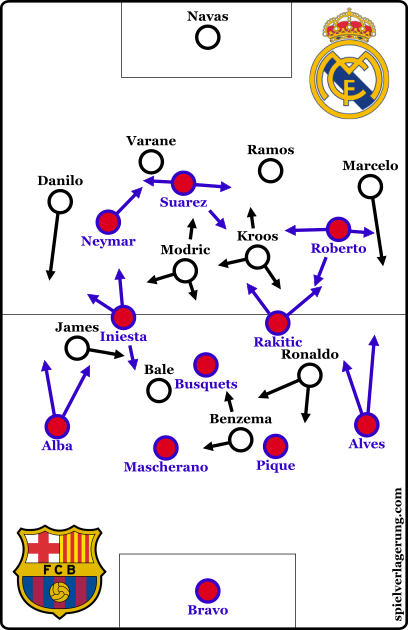
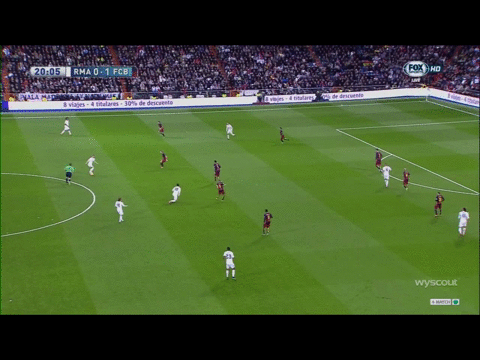


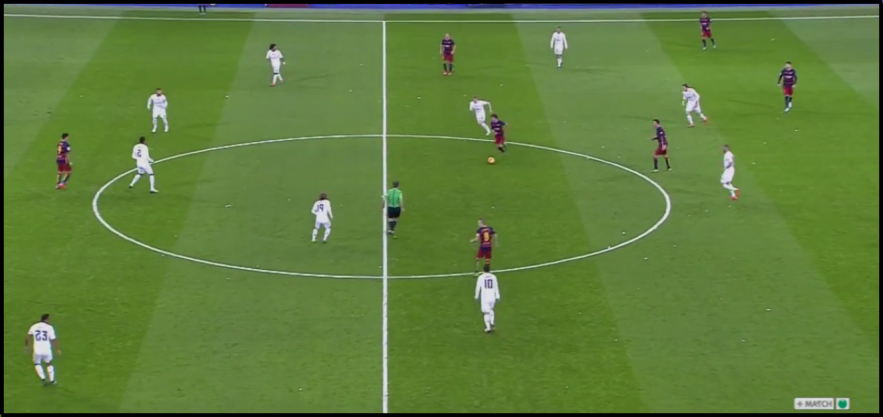
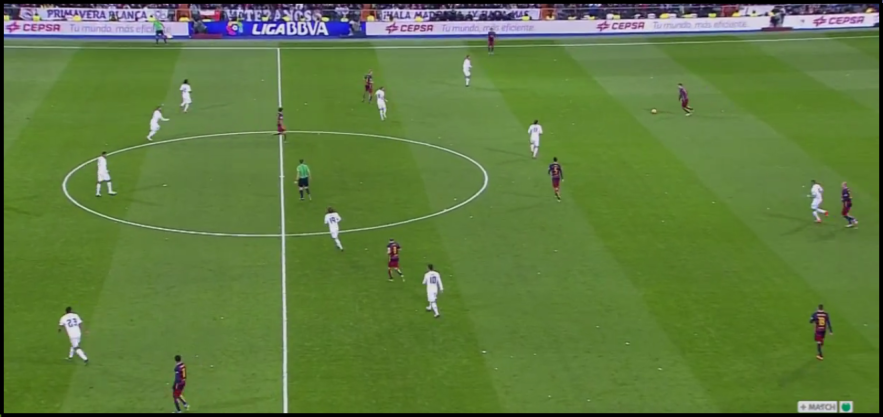
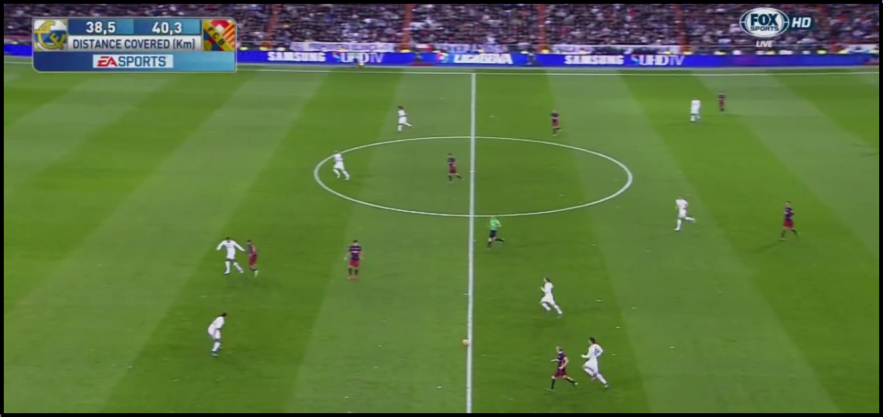
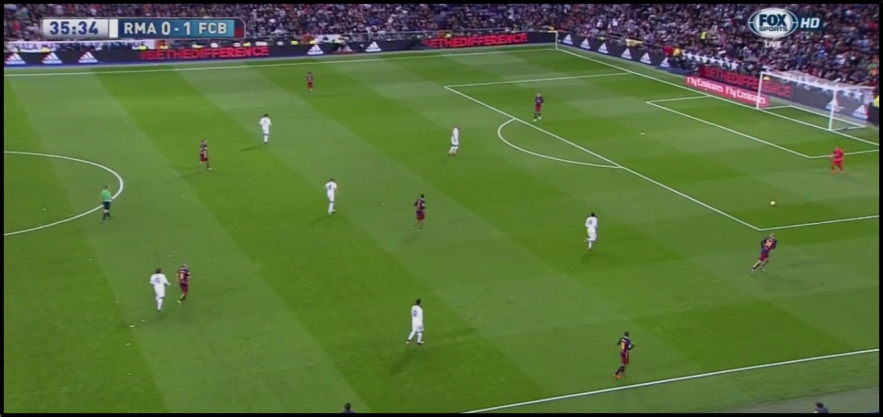

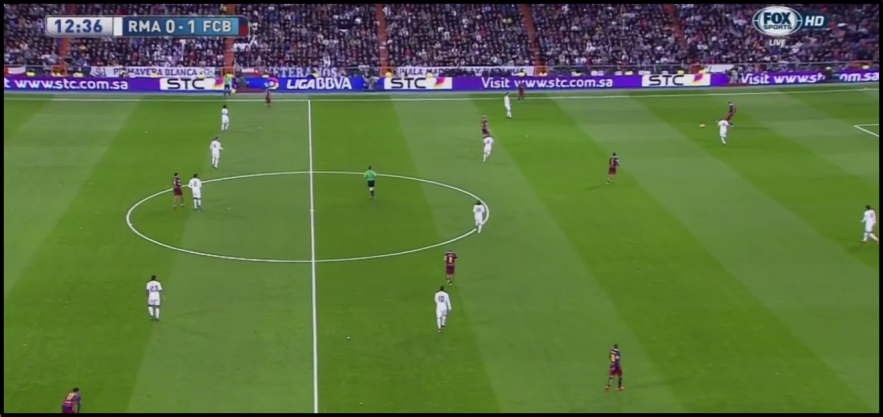

1 Kommentar Alle anzeigen
Valentin November 25, 2015 um 12:47 pm
I like the use of videos in this article. It would be great to see this regulary on this site but I know it’s often difficult to get those.
Concerning the match: Your conclusion is absolutely correct. I am suprised that the defensive structure and the compactness of Real are so bad. After the first games I heard that their compactness would be quite good, but in the three matches I’ve seen now (2nd match vs PSG, Sevilla, Clasico), their defensive organisation looked at times horrible. One of the screenshot shows especially well how much space Barca had between the lines, it’s nearly unbelievable!
The missing connections in the offense are not so much of a suprise for me, we all know this is a problem which often occurs for Real, especially when both Ronaldo and Bale play. Although this was also even more extreme in this match than in most of the other matches this season.
All in all I’d say that this was maybe the worst performance I’ve seen by Real since the arrival of Mourinho.